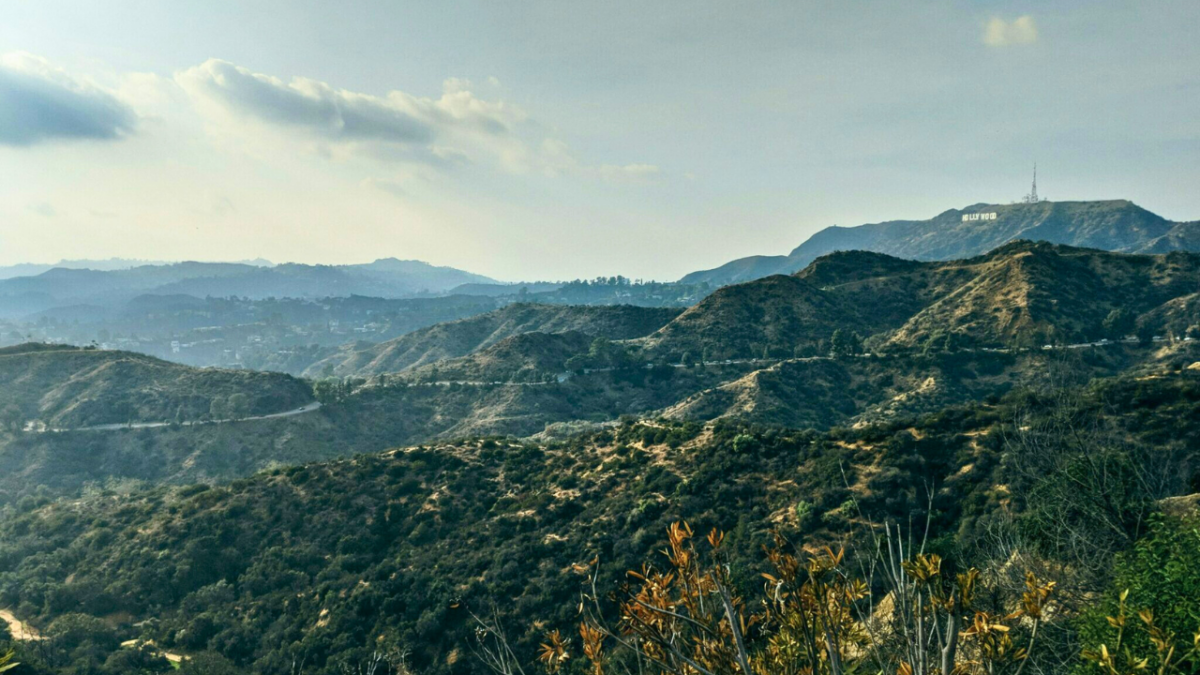
Ash below, blue sky above: Is the air safe?
UCLA professor and air-quality expert Suzanne Paulson answers questions about how to more confidently determine your local air quality, whether to mask outdoors and if the air is safe in Southern California.
Deciding whether the air is safe in Southern California can feel like a dangerous riddle in the week since the Palisades, Eaton and Hurst fires began.
Many air quality numbers have been shockingly good as the high winds that contributed to the devastation have also helped clear the smoke, but it’s hard to know whether that means the air is really clear, especially for people who can still smell the fires.
UCLA professor and air-quality expert Suzanne Paulson answered questions about how to more confidently determine your local air quality, how long Southern Californians will need to stay more alert about whether to mask outdoors, and that, yes — air quality really can be worse than the numbers show near the burn areas. Paulson is director of the UCLA Center for Clean Air, a member of UCLA’s Institute of the Environment and Sustainability and a professor in UCLA’s department of atmospheric and oceanic sciences.
How can I determine my hyperlocal air quality?
- Under most conditions the best source is the AQMD hourly AQI, found here, or here. The AQI system has been carefully designed to measure a small set of pollutants that are both toxic themselves and representative of whole classes of pollutants. The main factor controlling the hour-by-hour changes in concentrations of air pollutants is dilution, which is controlled by the atmosphere; all pollutants are diluted together. If the particle concentrations are low, the gas concentrations from the same source will usually be low as well. Low concentrations occur when the atmosphere is preventing pollutants from accumulating with winds and good vertical mixing. Also, the wind direction controls who is impacted by different pollution sources. You can be very close to a source on the upwind side and not be impacted. Individual AQI values on various apps, however, can be wildly inaccurate. They can be based on large areas and long averaging times, like 24 hours. It is best to ignore them.
- For rapidly changing conditions and highly localized pollution sources like fires, it is better to rely on a dense network of real-time sensors, such as PurpleAir, clarity, fire.airnow.gov. Note that the sensor networks only report PM2.5, but there are other pollutants to be concerned about (above). Still, when there are fires burning, the sensor networks above provide better spatial coverage, and higher temporal resolution, so more useful information.
- Especially on the PurpleAir network, individual sensors can be inaccurate, due to things like sensor error, nearby BBQ, etc., but several nearby sensors can provide are an excellent indicator of local air quality.
Do air-quality sensors measure all the harmful things in the atmosphere?
No. We do not have resources to measure everything. Sensor networks like PurpleAir only measure PM2.5. AQI is only based on PM10, PM2.5, nitrogen dioxide, Ozone, sulfur dioxide and carbon monoxide. We do not regularly measure asbestos, lead, other heavy metals, polyaromatic hydrocarbons, formaldehyde, etc. But usually that’s OK, because the concentrations of pollutants we do measure go up and down together with the ones we do not measure.
Can a local air quality index show that the air quality is good while missing dangerous pollutants or chemicals in the air?
Generally no. There are exceptions, however, including in/very close to burn areas or when there is another hyperlocal source, such as a poorly maintained diesel truck running its engine close by.
If you are not in a burn or burn-adjacent area, you can trust the AQI. (!) See the “Particulate Matter Pollution Primer” below for more info.
What should we do to protect ourselves when the air quality is bad?
Individual exposure is controlled by:
- The concentration of the particles and gasses polluting the air.
- The components (or toxicity) of those pollutants.
- How much an individual is breathing.
To reduce your exposure when the sensor networks/AQMD website etc. shows high levels of particles:
- Stay inside: Being inside with windows closed generally cuts concentrations of both particles down by roughly 50%. (Outdoor air has to get inside, otherwise you’d be suffocating in your house. Typically the volume of air in your house is exchanged around once per hour, via cracks and leaks. The regulated minimum is 0.35 “air changes” each hour.)
- Run AC, heating, or just the fan: Heating, fan, or AC further reduces concentrations, even without specific filtration installed in the HVAC system. The cleaning takes place because gases and particles stick and stay on surfaces as the air passes through the system. Heating and fan should have similar impacts; I am uncertain about the AC compared to the other two.
- Note that the basic filters many heating systems have do not help much with air quality inside the home since they are designed to keep much larger particles out of the HVAC system, not to clean the air. If you want more filtration, your heating system may be able to accommodate filters with higher MERV ratings (greater than approximately 13), which can further clean the air.
- Use air purifying HEPA or charcoal filters: HEPA filters can be highly effective at removing particles. Charcoal filters can reduce gas concentrations.
- Wear masks: The tighter fitting and more highly rated (N95, KN95) the better. These are designed to remove particles, but because air is forced to pass through very tight spaces, will reduce some gasses to an extent as well.
- Reduce exertion when concentrations are high: Keeping pets and kids inside when concentrations are high can reduce exposures for them by one half or more due to lower breathing rates.
Burn Areas
- In burn areas, precautions may be needed. Ash can contain a lot of toxic materials, and that can become airborne as it is disturbed. Some of this material isn’t picked up by the sensors. The readings especially near the fires ARE likely worse than they read, because the sensors don’t measure everything we would like. There are likely to be far more ash particles, “ultrafine” particles, gasses like polyaromatic hydrocarbons, and these can linger long after the fires are over.
- There are many resources for addressing the burn areas. The rest of us should know that debris and cleanup can be performed in a way that minimizes resuspension and creation of an on-going air pollution problem.
For how long do we need to be vigilant?
When the sensors are green or yellow and there is no obvious ash floating around, there is no reason to curtail activity now! I rode my bike to work on Wednesday Jan 15th. The air was much cleaner than average for my area (Santa Monica/Westwood).
While there are active burns, the particles may be more toxic than usual, so when the particle concentrations are higher there is reason for extra vigilance. In the burn areas, there may be reason for extra vigilance for an extended period, likely months.
Am I in a “burn adjacent” area?
This is very locally specific, e.g.:
- You are very close, like within several houses of the burn; probably YES.
- You are very close (within a half a mile or so) but were only briefly in the smoke plume and are not usually downwind of a burn area: then NO. But take precautions if you become downwind.
- You are close and were in the smoke plume for an extended period of time and are usually downwind of a burn area: then YES.
- There is lots of ash, but you are rarely downwind: take precautions as if in a burn area until the ash is removed (see online guidance on how to do that properly).
I smelled smoke when the AQI was “good”
There are some pretty hard to explain AQIs out there. A few reasons this might happen: The AQI is for a large area or for a long time scale (hourly, 24 hours) so it is missing smoke at a specific location and time. Or, you are in a burn area and the AQI cannot pick up the VOCs from smoke and ash deposited there. Or, that app is just wrong. There have been some perplexing values posted out there. Best to stick with the sites mentioned above and use precautions in burn areas regardless of the AQI.
I saw ash falling when the sky was blue
The ash is a completely different size from PM2.5 and PM10, so ash travels and deposits in different places. Imagine if you had a strong wind and tossed some feathers and pebbles. The feathers would be blown some distance, but the pebbles would fall more or less straight down.
The ash particles fall comparatively fast, like the pebbles and the PM2.5 and PM10 are the feathers. The ash usually falls nearby (within a few hundred feet) but it can travel further if it is lofted high into the atmosphere.
PM10 and PM2.5 particles stay in the air for many hours (PM10) or around a week (PM2.5). These particles are carried much, much further away. For inhalation exposure we only care about what is at the surface. Smoke could be aloft; it doesn’t impact what we breathe. And it can be hard to see from the ground once it is diluted, thus the sky can still look blue, even if a (diluted) smoke plume is going over head.
Are there more metals in the air after the wildfires than usual?
Almost all air pollution particles contain low levels of metals. These metals can, however, be very active biologically. Real time measurements showed extremely high levels of metals in the smoke plumes, but the airborne metal levels have now essentially returned to their normal levels. Heavy metals, and most of the PAHs are in/on the particles. Lead, for example, does not magically float around evading sensors. If the particle (PM2.5 and PM10) concentrations are low, the metal concentrations are low, even if there are more metals than usual in the particles.
Where did the smoke go? Is it still floating around in the LA Area?
Except the smoke that deposited on surfaces (and smoke from new fires) the smoke is gone! From the point of view of health impacts, “the solution to pollution is dilution”. The atmosphere is pretty good at mixing, and despite LA being a large area and the fires making lots of smoke, compared to the volume of the atmosphere both are very small. The smoke plume is now long gone, and it has been diluted as it mixes with other air. It takes only hours for air to move out of the Los Angeles area and on to somewhere else—over the ocean in the case of Santa Anas winds, or off to Arizona when we have a sea breeze. Even if the smoke goes just off the coast and encounters winds that blow it back in, it will get blown away, often in the other direction, within several more hours. The air also mixes vertically, diluting it and drastically lowering the pollutant concentrations.
What is the bottom line?
Except in and near burn areas, we are back to business as usual. For most people, believe the AQI and relax.
Also, use your new awareness of air quality to protect yourself and your family when we have poor air quality for reasons other than fires. The air commonly gets as bad as it was in parts of the smoke plume many times per year, including on the 4th of July, but other days too.
Particulate Matter Pollution Primer
“Particles”, Particulate Matter (PM), aerosol particles all refer to the same thing.
Different sizes of particles:
- PM2.5 = mass of all particles smaller than 2.5 microns. These particles stay in the atmosphere for around a week and penetrate deep into the lungs if inhaled.
- PM10 = mass of all particles smaller than 10 microns. PM2.5 is part of PM10, but because for example 1 10 micron diameter particle weighs the same as 1000 1 micron particles, and PM2.5 penetrate deeper in lungs than PM10 and usually come from combustion sources (particles between 2.5 and 10 microns come mostly from mechanical process, including wind blowing over surfaces) we have separate air quality standards to address both PM10 and PM2.5. Particles between 2.5 and 10 microns stay in the air for hours. Asbestos is included in PM10, so if PM10 is low, asbestos (even if a bit higher than usual in a relative sense) is also low.
- Ultrafine particles = particles smaller than 0.1 microns. These tend to be elevated around roadways and under the LAX flight path, and in smoke close to the source. They collide and stick to larger particles and become part of PM2.5. They stay in the atmosphere for around half an hour. These are not measured as part of AQI or any sensor network, unfortunately. Small total mass but able to cross cell walls; an emerging concern. Smoke, however, has plenty of PM2.5 particles so PM2.5 is sufficient to monitor the smoke; not a specific worry in wildfire situations.
- Ash and larger particles (above 10 microns). Larger particles (especially ash) are visible to the naked eye. They are not “respirable”, meaning they do not make it into the lungs. However, they can get into the upper airways (nose, throat) and become trapped in the mucus layer you have to protect yourself and swallowed. Ash is only locally transported by the wind, unless it is lofted high in the atmosphere (which happens in large fires), in which case it can be carried miles.
Wildfire smoke particles seem to be more problematic than motor vehicle PM and many other common urban particles. Fire-related particles may have higher levels of polyaromatic hydrocarbons and other problematic semi-volatile organics. They also typically contain wood-burning products that enhance metal activity in lung lining fluid, a discovery due to UCLA AOS. Smoke particles deposit on surfaces. If a lot of smoke entered an indoor space, there will be measurably elevated indoor concentrations of the semi-volatile organics until the indoor surfaces are cleaned (with water, in washing machines etc., by professionals depending on the amount and other factors such as sensitivity and risk tolerance), or until they slowly off gas/react away. The metals will be there until the surfaces are cleaned.
1/16/2025 Introduction & editing by Alison Hewitt, Q&A answers and background by Suzanne Paulson, questions by friends, family, the public and reporters.





